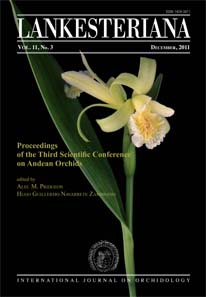The leaves got right again: DNA phylogenetics supports a sister-group relationship between Eurystyles and Lankesterella (Orchidaceae: Spiranthinae)
DOI:
https://doi.org/10.15517/lank.v11i3.18289Keywords:
Orchidaceae, Spiranthinae, Eurystyles, Lankesterella, molecular phylogenyAbstract
In spite of noticeable non-floral similarities such as their unusual epiphytic habit and vegetative morphology, Eurystyles and Lankesterella have been regarded by taxonomists who rank floral characters above all other sources of information as only distantly related. Here we assess the phylogenetic relationships of these genera, analyzing over 4500 characters of nuclear (nrITS) and plastid (matK-trnK, trnL-trnF) DNA sequences from 29 species/22 genera of Spiranthinae (plus appropriate outgroups); three structurally distinctive species of Eurystyles and two of Lankesterella were included. Both our parsimony and Bayesian phylogenetic analyses recovered Eurystyles and Lankesterella as sister taxa with strong internal support. The Eurystyles/Lankesterella clade is in turn supported as sister to the “Spiranthes clade.” Our results agree with previous interpretations of a close relationship between these two genera based on their shared epiphytic habit and similar vegetative morphology, indicating that floral morphology is evolutionarily labile in these groups and thus less reliable as an indicator of phylogenetic relationship than more conservative vegetative morphology.
Downloads
Downloads
Published
How to Cite
Issue
Section
License
According to the Open Access policy promoted by the University of Costa Rica, all the papers published by Lankesteriana are licensed under the Creative Commons copyright and can be downloaded free of charge. The journal holds copyright and publishing rights under the CC BY-NC-ND 3.0 CR license.
Before the publication of the materials submitted by the author(s) in LANKESTERIANA, the author(s) hereby assign all rights in the article to the Lankester Botanical Garden.








